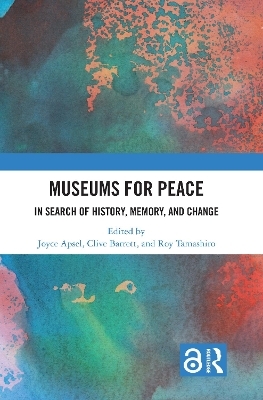
Museums for Peace
Routledge (Verlag)
978-1-032-27001-2 (ISBN)
Coming from various cultural and professional backgrounds, the authors explore “what are museums for peace and what do they mean?” Some chapters introduce alternative histories of peace, conflict, and memorialization. This innovative collection examines grassroots museums, military sexual slavery, historical memory in East Asia, and cultural heritage in the Africanized peace museum movement. The chapters discuss differing representations of Gandhi, technology of war and opposition to it, and structural violence such as racial terror and imperialism. Investigating how institutions interact with political and cultural forces, the volume demonstrates that some museums reinforce hegemonic narratives, while others resist authoritative tropes to reveal silenced histories, including peace histories.
Museums for Peace will appeal to academics and students in museum studies, heritage studies, peace studies, memory studies, social justice, and human rights. Those working in cultural studies and trauma studies will also find this volume valuable.
The Open Access version of this book, available at http://www.taylorfrancis.com, has been made available under a Creative Commons Attribution-Non Commercial-No Derivatives (CC-BY-NC-ND)] 4.0 license.
Joyce Apsel is Clinical Professor in Liberal Studies at New York University (USA) and President, the Institute for Study of Genocide. She is author of Introducing Peace Museums (2016), and co-editor of Museums and Sites of Persuasion (2020); Genocide Matters (2014) and Museums for Peace: Transforming Cultures (2012). Clive Barrett is Chair of Trustees of The Peace Museum, Bradford (UK) with 30 years of engagement with peace museums. His publications include Subversive Peacemakers (2014), and contributions to A Cultural History of Peace in the Age of Empire (2020) and the Blackwell Companion to Religion and Peace (2022). Roy Tamashiro is Professor Emeritus in Multidisciplinary Studies at Webster University (USA). His recent publications include contributed chapters to Building Positive Peace (2023); Oral History and Qualitative Methodologies (2022); Peace Journeys (2019); Museums and Sites of Persuasion (2019); and Pilgrimage as Transformative Process (2018).
Section 1. Setting the Scene; 1. Situating Museums for Peace: In Search of History, Memory, and Change; 2. Understanding “Museums for Peace”; Section 2. The Praxis of Museums for Peace; 3. Museums for Peace and Reconciliation in East Asia;4. The Africanized Peace Museum Movement and the Significance of Cultural Heritage; 5. Gandhi and Peace in the Museums of the World; 6. How Museums for Peace Depict the Technology of War and Opposition to It; Section 3. The Identification and Portrayal of Violence in Museums for Peace;7. Narrating the Military Sexual Enslavement System: Museums Caught in the Crossfire; 8. Japanese War Memory: Ongoing Challenges of Remembering and Forgetting; 9. Witnessing, Requiem, Reconciliation: Toward a Model for Curating Extreme Violence at Museums for Peace; Section 4. The Future of Museums for Peace;10. Concluding Voices
| Erscheinungsdatum | 28.12.2023 |
|---|---|
| Zusatzinfo | 5 Tables, black and white; 19 Halftones, black and white; 19 Illustrations, black and white |
| Verlagsort | London |
| Sprache | englisch |
| Maße | 156 x 234 mm |
| Gewicht | 689 g |
| Themenwelt | Kunst / Musik / Theater |
| Reisen ► Reiseführer | |
| Geisteswissenschaften ► Geschichte ► Hilfswissenschaften | |
| Sozialwissenschaften ► Politik / Verwaltung ► Europäische / Internationale Politik | |
| ISBN-10 | 1-032-27001-2 / 1032270012 |
| ISBN-13 | 978-1-032-27001-2 / 9781032270012 |
| Zustand | Neuware |
| Haben Sie eine Frage zum Produkt? |
aus dem Bereich


